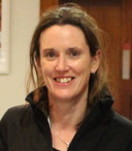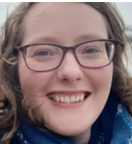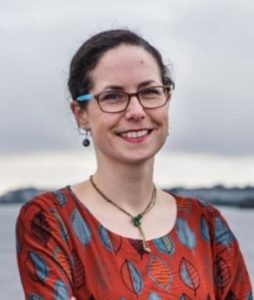This blog is part of the ‘Dispatches from Researchers’ series, which features guest articles written by experts in pollination and related fields.
The All-Ireland Pollinator Plan aims to provide food, shelter and safety for bees and other pollinators in Ireland, so that they can survive and thrive. Primarily this means making sure there are plenty of floral resources and places to nest, and removing threats to pollinator health. But because the insects that act as our pollinators are not all the same (there are more than 300 species of bee, hoverfly and butterfly in Ireland, with different feeding and nesting preferences, and different activity times during the year), this means that we need to cater for this diversity in our conservation actions. And the plants that these insects pollinate also vary in what habitats they live in, when they flower, and the quantity and quality of nectar and pollen they produce.
With all this variation, how do we determine what’s best for our pollinator community as a whole?
To answer this question, Laura Russo, pollination ecology expert, who was working at Trinity College Dublin, took advantage of ten years of plant-pollinator interaction data amassed by Jane Stout‘s research team and collaborators. This remarkable dataset, built up mainly by graduate students (supported by the EPA, IRC, TCD and EU), contained information from 119 sites across Ireland, from cultivated and built land, coastlands, semi-natural and marshy grasslands, hedgerows, woodlands and scrub (Figure 1).
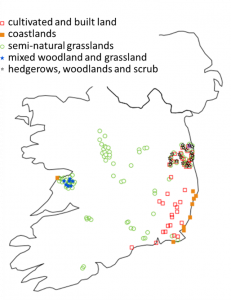
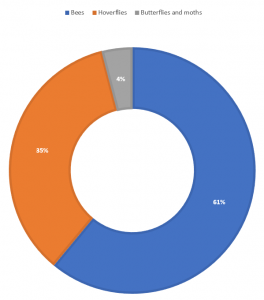
Although all the data were collected in the same way, using the transect walk method, different sites were sampled in different years by different people, according to the projects on which they were working. Nonetheless, this is the biggest dataset of plant-pollinator interactions that we have. The dataset included 148 insect species, visiting 239 flowering plant species, from observations made between April and October in various studies from 2009 to 2018. Around half of the species in the dataset were hoverflies (55%), a third were bees (31%) and the rest were butterflies and moths. However, in terms of abundance on flowers, the bees dominated (61% of visits were by bees, 35% by hoverflies) (Figure 2).
The team, led by Laura, analysed the complex patterns of interactions (Figure 3) between insects and the flowers they were observed visiting, using sophisticated analytical and statistical techniques. The full details of which are given in the academic paper.
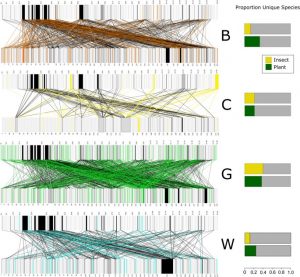
The five key take-home messages from analysis of these networks were:
- When there were more flowers, more insects were recorded. This seems to support the notion that more flowers are good news for supporting more insects, regardless of what sort of habitat type you’re in.
- At the core of these communities of plants and insects were abundant, widespread flower types, which were visited by lots of bees. Bramble, white clover, creeping buttercups, knapweeds, creeping thistle, and hawkbit were all identified as important, but they are also the most abundant and widespread. However, this doesn’t mean that rare plants don’t matter: they do – rare plants were important for rare pollinators.
- Half of all the flower visitor species were hoverflies, suggested that flies are undervalued contributors to pollination services in Ireland. There were very low numbers of butterflies visiting flowers across all these sites.
- In terms of abundance, bees dominate. Bumblebees are an especially core component of the Irish bee pollinating fauna, especially dominant species like the common carder (Bombus pascuorum).
- Semi-natural grassland sites are particularly important: they had the most pollinator species and greatest number of visits, and the communities were most “distinct”, which means they were different from other sites, and contained the most rare species. On the other hand, intensely managed habitats (urban, crops and silage/dairy) had poor pollinator diversity, despite abundant ornamental plants in urban sites.
How does Ireland compare with other places?
Interestingly, compared with similar datasets of plant-pollinator interactions from other countries, we see some key differences. One is that the Irish interaction networks had a higher ratio of plant species to pollinator species than in other places, especially in agricultural habitats. This is important because the reverse, a higher ratio of insects to plants, is thought to be more resilient to environmental change. This is because when there are more insect species, there is more ecological redundancy, which buffers the network against loss of ipollination services. Put simply, insects are more variable year to year and place to place than plants, and the temporary loss of insect species from a network could threaten ecosystems more than loss of plants, which tend not to have such temporal variation. Moreover, insects may be more sensitive to habitat disturbance, and may disappear first as land-use intensifies. So, in Irish highly managed habitats (cultivated and urban), networks are more at risk.
What does this mean in terms of conservation here in Ireland? What plants or habitats should we be encouraging to support pollinators?
A key conclusion from this work is that Irish semi-natural grasslands are essential for pollinator conservation. This is because they support the most species, including the rarer species that aren’t found in more highly managed habitat types, and a higher proportion of threatened bee species. They have lower proportions of non-native plant species too, so are also important for native plant conservation.
In terms of which plant species are most important for pollinator conservation, 35 species were identified that rank in the top ten using different measures of “importance”; including how often they were visited, how abundant visitors were, the number of species visiting, their role as a “hub” for interacting species, how long they flower for, and whether they were supporting different insects to other plants in the network (Figure 4). These species include the common and familiar in the Irish countryside, as well as some less well-known species that prefer specialised habitats, like the water figwort.
Given most of Ireland is covered in highly managed habitats (agricultural crops, silage and dairy pastures, and urban and suburban gardens and flower beds), it is concerning that these habitats were supporting relatively fewer insect species. Urban habitats had more non-native plant species, which isn’t surprising considering most garden plants are not native to Ireland. But this increase in non-native plant species didn’t correspond to an increase in insect diversity. Thus, getting native plant diversity back into our highly managed habitats is important to support pollinator communities.
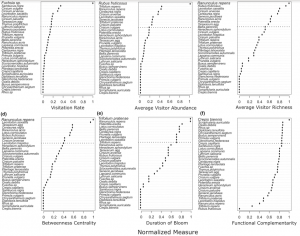
Find out more:
Read the full paper at https://onlinelibrary.wiley.com/doi/10.1002/ece3.9347.
About the authors:


